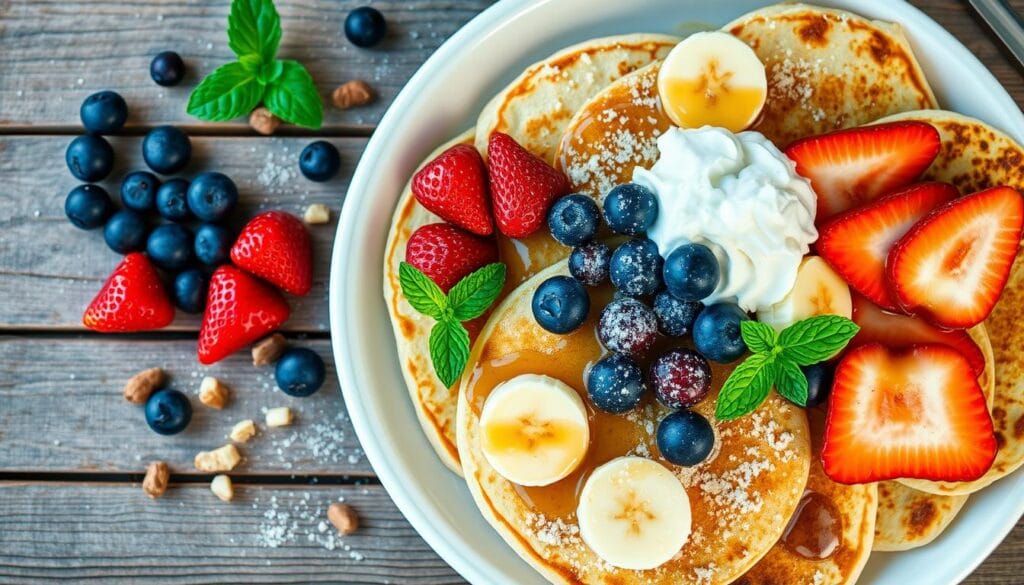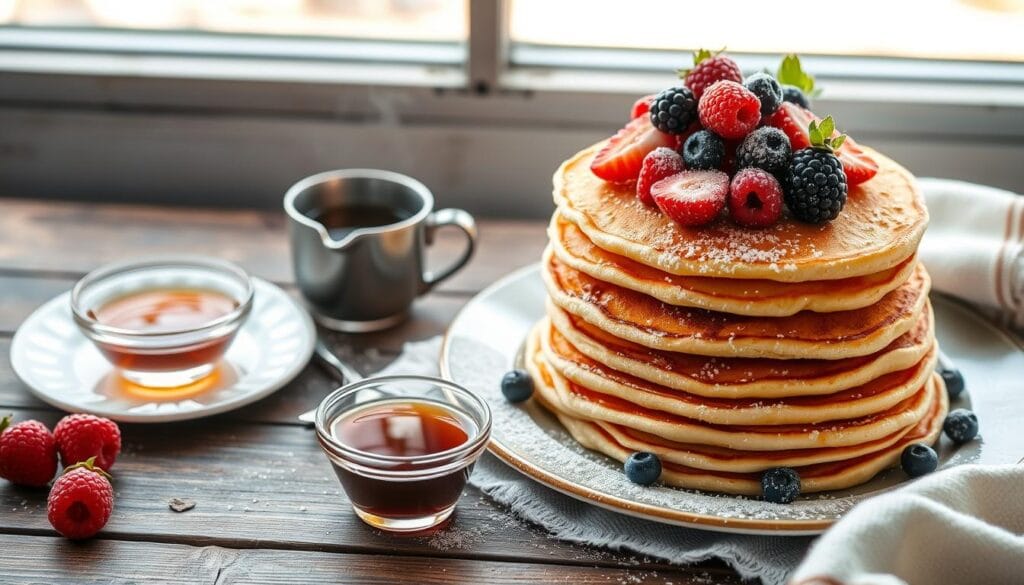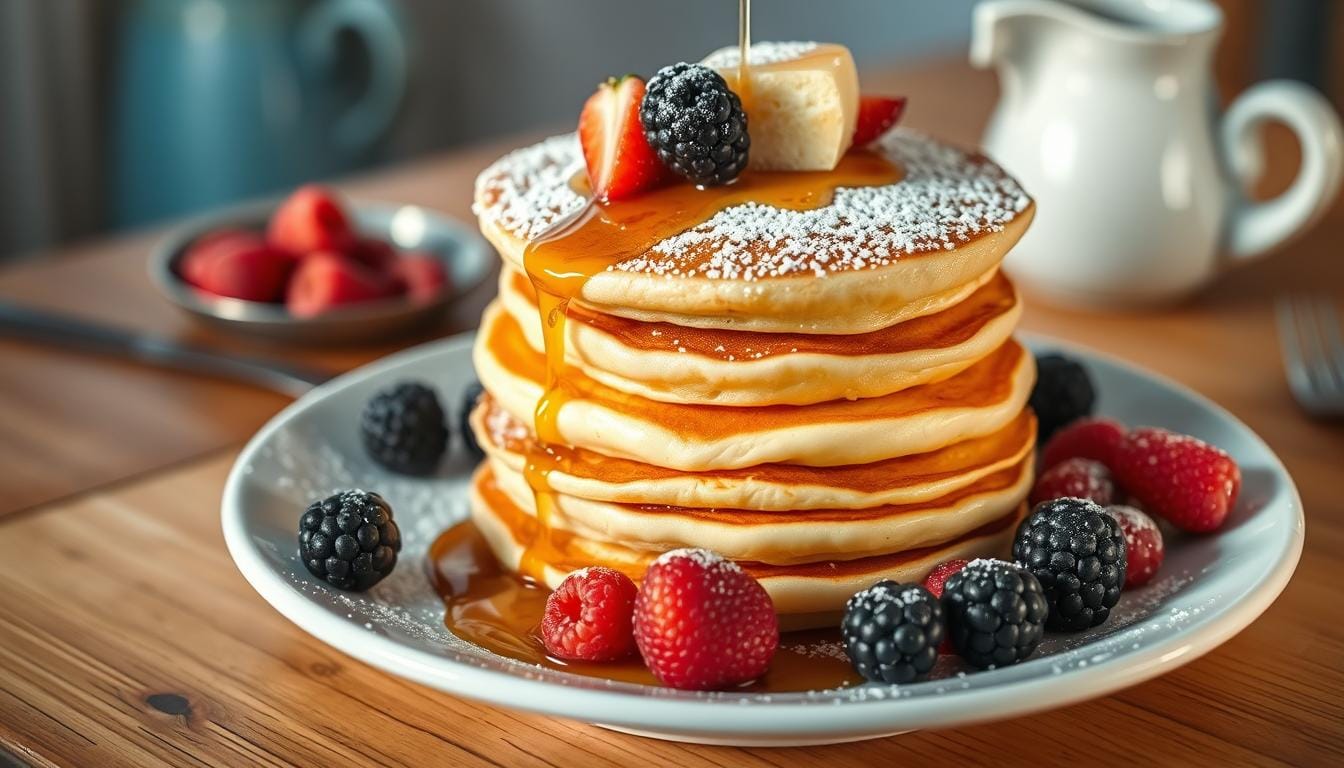I remember my first bite of german pancakes. It was love at first taste. The texture was light and fluffy, the color deep golden. The recipe was simple yet unforgettable.
Homemade pancakes are easy to make. They need just 6 ingredients and 5 minutes to prepare. They’ve become a favorite in my home.
German pancakes are different from regular pancakes. They use whole milk, eggs, and lemon juice. This mix gives them a rich, tasty flavor. They’re great for any meal or a quick breakfast.
In this article, I’ll share my top classic pancakes recipe. I’ll also give tips for making them fluffy and golden. We’ll talk about using quality ingredients and getting the perfect puff. If you want to elevate your breakfast with authentic pancakes, keep reading.
What Are Dutch Pancakes?
They are, also known as Dutch baby pancakes or German puff pancakes, are a breakfast favorite. They are made with flour, eggs, sugar, and milk. Baked in the oven, they puff up beautifully. I love starting my day with a traditional german pancake recipe for a german pancake breakfast.
The history of dutch pancakes goes back to Germany. They are thicker and fluffier than regular pancakes.
A Brief History of German Pancakes
German pancakes have been loved for centuries. They are often topped with fresh berries, powdered sugar, or buttermilk syrup. This makes them a tasty and filling breakfast choice.
Differences Between German and Traditional Pancakes
German pancakes and traditional pancakes differ in batter and cooking. German pancakes are baked in the oven. Traditional pancakes are cooked on a griddle or frying pan. This makes German pancakes unique, perfect for a german pancake breakfast.
Ingredients for German Pancakes
To make authentic pancakes, you need eggs, flour, milk, and butter. These are the key ingredients for a classic easy german pancake recipe. When you make dutch pancakes from scratch, using top-quality ingredients is important.
The basic ingredients for German pancakes are simple. But, the quality of each ingredient matters a lot. For example, using fresh eggs and real butter makes your pancakes taste better and feel softer. The flour you choose also changes how the pancake turns out.
Some recipes might ask for extra ingredients like salt, powdered sugar, or vanilla extract. For a fun twist, you can also try this sourdough pancake recipe for added depth of flavor. But, these four basic ingredients are the heart of a traditional German pancake recipe. By using these ingredients and a simple easy dutch pancake recipe, you can make tasty pancakes from scratch that everyone will love.
Next, we’ll talk about the tools you need to make German pancakes. This includes the best pan to use and other important kitchen tools. With the right ingredients and tools, you’ll be ready to make authentic Bavarian Pancakes that taste great and look good too.
Equipment Needed
To make delicious European Pancakes, you need basic kitchen tools. A 9×13-inch pan is key for even cooking and puffing. It’s the best size for Bavarian Pancakes, my research shows.
For german pancake toppings, you can be creative. But, you must have a few essential tools. These include a mixing bowl, whisk, and a 9×13-inch pan. You can find these at kitchen stores or online.
Must-Have Kitchen Tools
You’ll also need a mixing bowl, whisk, and spatula for European Pancakes. These tools help mix the batter and flip the pancake. Many german pancakes recipe guides online list these basic tools.

Recommended Cookware for Best Results
A 9×13-inch pan is the minimum for European Pancakes. But, other pans can also work well. A cast-iron skillet or non-stick pan can prevent sticking and ensure even cooking. Try different pans to find your favorite for your Eggy Pancakes recipe.
How to Make Eggy Pancakes
To make tasty homemade Puffed Pancakes, first heat your oven to 400°F. This helps cook your pancakes just right. In a big bowl, mix eggs, milk, flour, and salt until it’s smooth. The batter for fluffy german pancakes is a blend of these ingredients, smooth in a blender.
Then, add melted butter to the mix and stir well. Pour the batter into a 13×9-inch baking dish. Bake for 20 minutes, or until it’s puffed and golden. You’ll get a yummy, fluffy german pancake ready for your favorite toppings like honey, maple syrup, powdered sugar, or fresh fruits.
Step-by-Step Instructions
For a perfect homemade german pancake, just follow these steps: preheat, mix the batter, add butter, and bake until golden. These easy steps will help you make a delicious fluffy german pancake that everyone will love.
Don’t overmix the batter, or your pancake might be dense. With the right ingredients and a bit of practice, you can make perfect homemade Puffed Pancakes every time.
The Perfect Baking Temperature
When making an authentic german pancake recipe, the baking temperature is key. It helps get the perfect puff and golden brown color. The third web source says the best temperature is 425°F (220°C).
This temperature makes the pancake puff up nicely and turn golden brown.
A traditional german pancake recipe usually bakes in a hot oven. The baking time is about 20 minutes. The pancake should be puffed and golden brown by then.
It’s important to watch the pancake while it bakes. The time can change based on the oven and pancake size.
To see if it’s done, stick a toothpick into the center. If it comes out clean, it’s ready. You can also check the color and texture. It should be golden brown and puffed.
By following these tips and using the right temperature, you’ll make a delicious authentic german pancake recipe. It’s sure to impress everyone.
Toppings and Serving Suggestions
German pancakes are like a blank canvas. They’re waiting for your favorite toppings. Try fresh berries, maple syrup, or powdered sugar for a sweet touch.
Looking to get creative? Try fresh fruit like strawberries or bananas. Whipped cream or yogurt add a tangy twist. Cinnamon sugar or nutella make it sweet and indulgent.
But there’s more than just sweet toppings. Savory variations like cheese or herbs offer a tasty surprise. They’re great for a hearty breakfast or brunch.
Common Mistakes to Avoid
When making Puffed Pancakes from scratch, it’s key to avoid common mistakes. Overmixing the batter can make pancakes dense. To fix this, mix the ingredients just until they’re combined, then stop.
Another mistake is using the wrong baking times. Homemade german pancakes need a specific baking time to puff up right. Preheat the oven correctly and bake for the right time. Wrong baking times can ruin the pancakes.
To make delicious and fluffy homemade Puffed Pancakes, avoid these mistakes. Use fresh eggs and buttermilk, and don’t overmix. With practice, you’ll soon make perfect European Pancakes from scratch.
Storing Leftover Pancakes
After enjoying a delicious german pancake breakfast, you might have leftovers. It’s important to store them right to keep them fresh. Leftover European Pancakes can stay good in the fridge for up to 2 days.
When storing leftover pancakes, use an airtight container or a Ziplock bag. This keeps them fresh. You can also refrigerate the batter overnight and bake fresh in the morning. For longer storage, freeze them with parchment paper in between to prevent sticking.
Best Practices for Refrigeration
To refrigerate leftover pancakes, place them in a single layer in an airtight container or bag. This prevents moisture buildup and keeps them fresh. You can store them in the fridge for up to 2-3 days.
How to Reheat German Pancakes
Reheating german pancakes is easy and quick. You can use the oven or microwave. Just place the pancakes in the oven at a low temperature or microwave them for a few seconds until warm and fluffy.
By following these simple steps, you can enjoy your leftover European Pancakes for a longer time. They will taste just as delicious as when they were first made.
Frequently Asked Questions
Exploring European Pancakes brings up many questions. I’ll answer two big ones: can I use whole wheat flour, and how to make gluten-free German pancakes? These questions are key when looking for a real German pancake recipe.
Yes, you can use whole wheat flour instead of all-purpose flour. It might change the pancake’s texture and taste a bit. To get the best results, adjust the liquid and add xanthan gum for better texture.
Gluten-Free German Pancakes
To make gluten-free German pancakes, use a mix of rice, almond, and coconut flour. It’s important to adjust the flour mix and add xanthan gum. This way, you can make fluffy gluten-free pancakes perfect for breakfast or brunch.

I hope answering these questions helps you understand making German pancakes with different flours. Whether you want a real German pancake recipe or a traditional one, the secret is to try different ingredients and methods. This will help you find the perfect recipe for you.
Nutritional Information
Many of us wonder about the nutritional value of European Pancakes from scratch. A serving has about 167 calories. This makes homemade german pancakes a good choice, depending on the ingredients.
For a healthier option, use Fairlife milk for more protein. Alternatively, try this gluten-free pancake recipe for a diet-friendly breakfast treat. Try Choc Zero syrup for 35 calories, 15 grams of fiber, and 0g sugar. Adding berries boosts antioxidants and anti-inflammatory proteins.
A serving of german pancakes has 25g of protein, 26g of carbs, and 11g of fat. Use Kodiak Cakes for 30g of carbs, 5g of fiber, and 3g of sugar. With creativity, you can have a nutritious and tasty breakfast with homemade german pancakes.
Caloric Breakdown of German Pancakes
A typical serving of European Pancakes has 167 to 304 calories. Making simple changes, like using sugar-free syrup or keto mix, can make it healthier.
Adjustments for Healthier Options
To make german pancakes healthier, reduce sugar and saturated fat. Add eggs or Greek yogurt for more protein. With some experimentation, you can make a healthy and tasty german pancakes from scratch that fits your diet.
Variations on the Classic Recipe
The traditional German pancake recipe is a classic delight. But, there’s room to try new and creative twists. A sweet version can be made by topping it with fresh german pancake toppings like strawberries, blueberries, or powdered sugar.
For a savory twist, add sautéed mushrooms, caramelized onions, or shredded cheese.
Sweet vs. Savory German Pancakes
German pancakes are versatile. You can make them a decadent dessert or a satisfying main dish. Try sweet toppings like apple slices, cinnamon, and maple syrup.
Or, go savory with roasted veggies, crumbled bacon, and sour cream.
Regional Variations to Explore
German cuisine varies across regions, and so do their pancakes. Another regional favorite is this IHOP pancake recipe, perfect for recreating the classic diner experience at home. In some places, you’ll find easy german pancake recipe versions with bananas or seasonal fruits.
Other areas might have fillings like cheese, spinach, or savory meats. The most important thing is to have fun and be creative.
FAQ
Can I use whole wheat flour to make German pancakes?
Yes, you can use whole wheat flour for German pancakes. They might be a bit denser. But they will be delicious and fluffy.
How do I make gluten-free German pancakes?
For gluten-free German pancakes, use a gluten-free flour mix. Bob’s Red Mill and King Arthur Flour make great mixes for this recipe.
Can I refrigerate and reheat leftover German pancakes?
Yes, you can keep leftover German pancakes in the fridge for 2 days. To reheat, warm them in a 350°F oven for 5-10 minutes. Or microwave in 30-second bursts until warm.
Are German pancakes a healthy breakfast option?
German pancakes can be a healthy breakfast choice. Use low-fat milk and less sugar. Top with fresh fruit for a healthier option.
Can I make savory versions of German pancakes?
Absolutely! German pancakes can be both sweet and savory. Add herbs, cheese, or sautéed veggies to the batter for a tasty savory version.

